Assessments of Secondary Reinforcement of Epoxy Matrix-Glass Fibre Composite Laminates through Nanosilica (SiO2)
Abstract
:1. Introduction
2. Materials and Methods
2.1. Preparation of Nano Composites
2.2. Characterization Studies
2.2.1. Tensile and Flexural Tests
2.2.2. Quasi Static Indentation Tests
2.2.3. XRD Analysis
2.2.4. Dynamic Mechanical Analysis
2.3. Failure Analysis
2.3.1. Scanning Electron Microscopy
2.3.2. Non-Destructive Evaluation Using C-Scan
3. Results and Discussions
3.1. Characterisation Results
3.1.1. XRD Analysis
3.1.2. Dynamic Mechanical Analysis (DMA) Response
3.1.3. Tensile Response
3.1.4. Three Point Bending Response
3.1.5. Quasi Static Indentation Test Results
3.2. Failure Analysis
3.2.1. Fiber-Matrix Interfacial Bonding and Fracture Analysis
3.2.2. Internal Damage Due to Quasi Static Compression
4. Conclusions
Author Contributions
Conflicts of Interest
References
- Karger-Kocsis, J.; Harmia, T.; Czigany, T. Comparison of the fracture and failure behaviour of polypropylene composites reinforced by long glass fibers and by glass mats. Compos. Sci. Technol. 1995, 54, 287–298. [Google Scholar] [CrossRef]
- Hale, J. Boeing 787 from the ground up. Aero Mag. Boeing 2006, 24, 17–23. [Google Scholar]
- Okoli, O.I.; Smith, G.H. Failure modes of fibre reinforced composites: The effects of strain rate and fibre content. J. Mater. Sci. 1998, 33, 5415–5422. [Google Scholar] [CrossRef]
- Choi, H.Y.; Wu, H.Y.T.; Chang, F.K. A new approach toward understanding damage mechanisms and mechanics of laminated composites due to low-velocity impact: Part II—Analysis. J. Compos. Mater. 1991, 25, 1012–1038. [Google Scholar] [CrossRef]
- Aoki, Y.; Suemasu, H.; Ishikawa, T. Damage propagation in CFRP laminates subjected to low velocity impact and static indentation. Adv. Compos. Mater. 2007, 16, 45–61. [Google Scholar] [CrossRef]
- Chang, T.D.; Brittain, J.O. Studies of epoxy resin systems: Part D: Fracture toughness of an epoxy resin: A study of the effect of crosslinking and sub-Tg aging. Polym. Eng. Sci. 1982, 22, 1228–1236. [Google Scholar] [CrossRef]
- Garg, A.C.; Mai, Y.W. Failure Mechanisms in toughened epoxy resins—A review. Compos. Sci. Technol. 1988, 31, 179–223. [Google Scholar] [CrossRef]
- Ha, S.R.; Ryu, S.H.; Park, S.J.; Rhee, K.Y. Effect of clay surface modification and concentration on the tensile performance of clay/epoxy nanocomposites. Mater. Sci. Eng. A 2007, 448, 264–268. [Google Scholar] [CrossRef]
- Qi, B.; Zhang, Q.X.; Bannister, M.; Mai, Y.W. Investigation of the mechanical properties of DGEBA-based epoxy resin with nanoclay additives. Compos. Struct. 2006, 75, 514–519. [Google Scholar] [CrossRef]
- Ruiz-Perez, L.; Royston, G.J.; Fairclough, P.A.; Ryan, A.J. Toughening by nanostructure. Polymer 2008, 49, 4475–4488. [Google Scholar] [CrossRef]
- Elango, N.; Faudzi, A.A.M. A review article: investigations on soft materials for soft robot manipulations. Int. J. Adv. Manuf. Technol. 2015, 80, 1027–1037. [Google Scholar] [CrossRef] [Green Version]
- Mokhireva, K.A.; Svistkov, A.L.; Solod’ko, V.N.; Komar, L.A.; Stöckelhuber, K.W. Experimental analysis of the effect of carbon nanoparticles with different geometry on the appearance of anisotropy of mechanical properties in elastomeric composites. Polym. Test. 2017, 59, 46–54. [Google Scholar] [CrossRef]
- Karapappas, P.; Vavouliotis, A.; Tsotra, P.; Kostopoulos, V.; Palpetis, A. Enhanced fracture properties of carbon reinforced composites by the addition of multi-wall carbon nanotubes. J. Compos. Mater. 2009, 43, 977–985. [Google Scholar] [CrossRef]
- Saboori, B.; Ayatollahi, M.R. Experimental fracture study of MWCNT/Epoxy nanocomposites under the combined out-of-plane shear and tensile loading. Polym. Test. 2017, 59, 193–202. [Google Scholar] [CrossRef]
- Golshahr, A.; Natarajan, E.; Santhosh, M.S.; Sasikumar, R.; Ramesh, S.; Durairaj, R. Multi wall carbon nanotube reinforced silicone for aerospace applications. Int. J. Mech. Prod. Eng. Res. Dev. 2018, 8, 775–784. [Google Scholar]
- Tang, L.C.; Wan, Y.J.; Yan, D.; Pei, Y.B.; Li, Y.B.; Wu, L.B.; Jiang, J.X.; Lai, G.Q. The effect of graphene dispersion on the mechanical properties of graphene/epoxy composites. Carbon 2013, 60, 16–27. [Google Scholar] [CrossRef]
- Al-Maharma, A.Y.; Sendur, P. The effect of inter-laminar graphene nano-sheets reinforced e-glass fiber/epoxy on low velocity impact response of a composite plate. Mater. Res. Express 2018, 5, 055021. [Google Scholar] [CrossRef]
- Zaman, I.; Phan, T.T.; Kuan, H.C.; Meng, Q.S.; La, L.T.B.; Luong, L.; Youssf, O.; Ma, J. Epoxy/graphene platelets nanocomposites with two levels of interface strength. Polymer 2011, 52, 1603–1611. [Google Scholar] [CrossRef] [Green Version]
- Zappalorto, M.; Salviato, M.; Quaresimin, M. Mixed mode (I + II) fracture toughness of polymer nano-clay nano composites. Eng. Fract. Mech. 2013, 111, 50–64. [Google Scholar] [CrossRef]
- Guevara-Morales, A.; Taylor, A.C. Mechanical and dielectric properties of epoxy–clay nano composites. Mater. Sci. 2014, 49, 1574–1584. [Google Scholar] [CrossRef]
- Krushnamurty, K.; Srikanth, I.; Rangababu, B.; Majee, S.K.; Bauri, R.; Subrahmanyam, C. Effect of nano clay on the toughness of epoxy and mechanical, impact properties of E-glass-epoxy composites. Adv. Mater. Lett. 2015, 6, 684–689. [Google Scholar] [CrossRef] [Green Version]
- Chen, Z.K.; Yang, J.P.; Ni, Q.Q.; Fu, S.Y.; Huang, Y.G. Reinforcement of epoxy resins with multiwalled carbon nanotubes for enhancing cryogenic mechanical properties. Polymer 2009, 60, 4753–4759. [Google Scholar]
- Zhang, H.; Tang, L.C.; Zhang, Z.; Friedrich, K.; Sprenger, S. Fracture behaviour of in situ silica nanoparticle-filled epoxy at different temperatures. Polymer 2008, 49, 3816–3826. [Google Scholar] [CrossRef]
- Coleman, J.; Khan, U.; Gun’ko, Y. Mechanical reinforcement of polymers using carbon nanotubes. Adv. Mater. 2006, 18, 689–706. [Google Scholar] [CrossRef]
- Moniruzzaman, M.; Winey, K.I. Polymer nanocomposites containing carbon nanotubes. Macromolecules 2006, 39, 5194–5205. [Google Scholar] [CrossRef]
- Breuer, O.; Sundararaj, U. Big returns from small fibers: A review of polymer/carbon nanotube composites. Polym. Compos. 2004, 25, 630–645. [Google Scholar] [CrossRef]
- Bal, S.; Samal, S.S. Carbon nanotube reinforced polymer composites—A state of the art. Bull. Mater. Sci. 2007, 30, 379–386. [Google Scholar] [CrossRef]
- Liao, Y.H.; Marietta-Tondin, O.; Liang, Z.; Zhang, C.; Wang, B. Investigation of the dispersion process of SWNTs/SC-15 epoxy resin nanocomposite. Mater. Sci. Eng. 2004, A385, 175–181. [Google Scholar] [CrossRef]
- Montazeri, A.; Montazeri, N.; Pourshamsian, K.; Tcharkhtchi, A. The effect of sonication time and dispersing medium on the mechanical properties of multiwalled carbon nanotube (MWCNT)/epoxy composite. Int. J. Polym. Anal. Charact. 2011, 16, 465–476. [Google Scholar] [CrossRef]
- Elango, N.; Gupta, N.S.; Lih Jiun, Y.; Golshahr, A. The effect of high loaded multiwall carbon nanotubes in natural rubber and their nonlinear material constants. J. Nanomater. 2017, 2017. [Google Scholar] [CrossRef]
- Gong, L.X.; Hu, L.L.; Zang, J.; Pei, Y.B.; Zhao, L.; Tang, T.C. Improved interfacial properties between glass fibers and tetra-functional epoxy resins modified with silica nanoparticles. Fibers Polym. 2015, 16, 2056–2065. [Google Scholar] [CrossRef]
- Fathy, A.; Shaker, A.; Hamid, M.A.; Megahed, A.A. The effects of nanosilica/nano-alumina on fatigue behavior of glass fiber-reinforced epoxy composites. J. Compos. Mater. 2017, 51, 1667–1679. [Google Scholar] [CrossRef]
- Johnsen, B.B.; Kinloch, A.J.; Mohammed, R.D.; Taylor, A.C.; Sprenger, S. Toughening mechanisms of nanoparticle-modified epoxy polymers. Polymer 2007, 48, 530–541. [Google Scholar] [CrossRef] [Green Version]
- Lal, L.P.J.; Ramesh, S.; Elango, N. Study on the repeatability of manufacturing nanosilica (SiO2) reinforced composite laminates. Mater. Sci. Eng. 2018, 346, 012083. [Google Scholar]
- Tolle, T.B.; Anderson, D.P. Morphology development in layered silicate thermoset nanocomposites. Compos. Sci. Technol. 2018, 62, 1033–1041. [Google Scholar] [CrossRef]
- Gurusideswar, S.; Velmurugan, R.; Gupta, N.K. Study of rate dependent behaviour of glass/epoxy composites with nanofillers using non-contact strain measurement. Inte. J. Impact Eng. 2017, 110, 324–337. [Google Scholar] [CrossRef]
- Afrouzian, A.; Movahhedi Aleni, H.; Liaghat, G.; Ahmadi, H. Effect of nano-particles on the tensile, flexural and perforation properties of the glass/epoxy composites. J. Reinf. Plast. Compos. 2017, 36, 900–916. [Google Scholar] [CrossRef]
- Gauvin, F.; Cousin, P.; Robert, M. Improvement of the interphase between basalt fibers and vinylester by nano-reinforced post-sizing. Fibers Polym. 2015, 16, 434–442. [Google Scholar] [CrossRef]
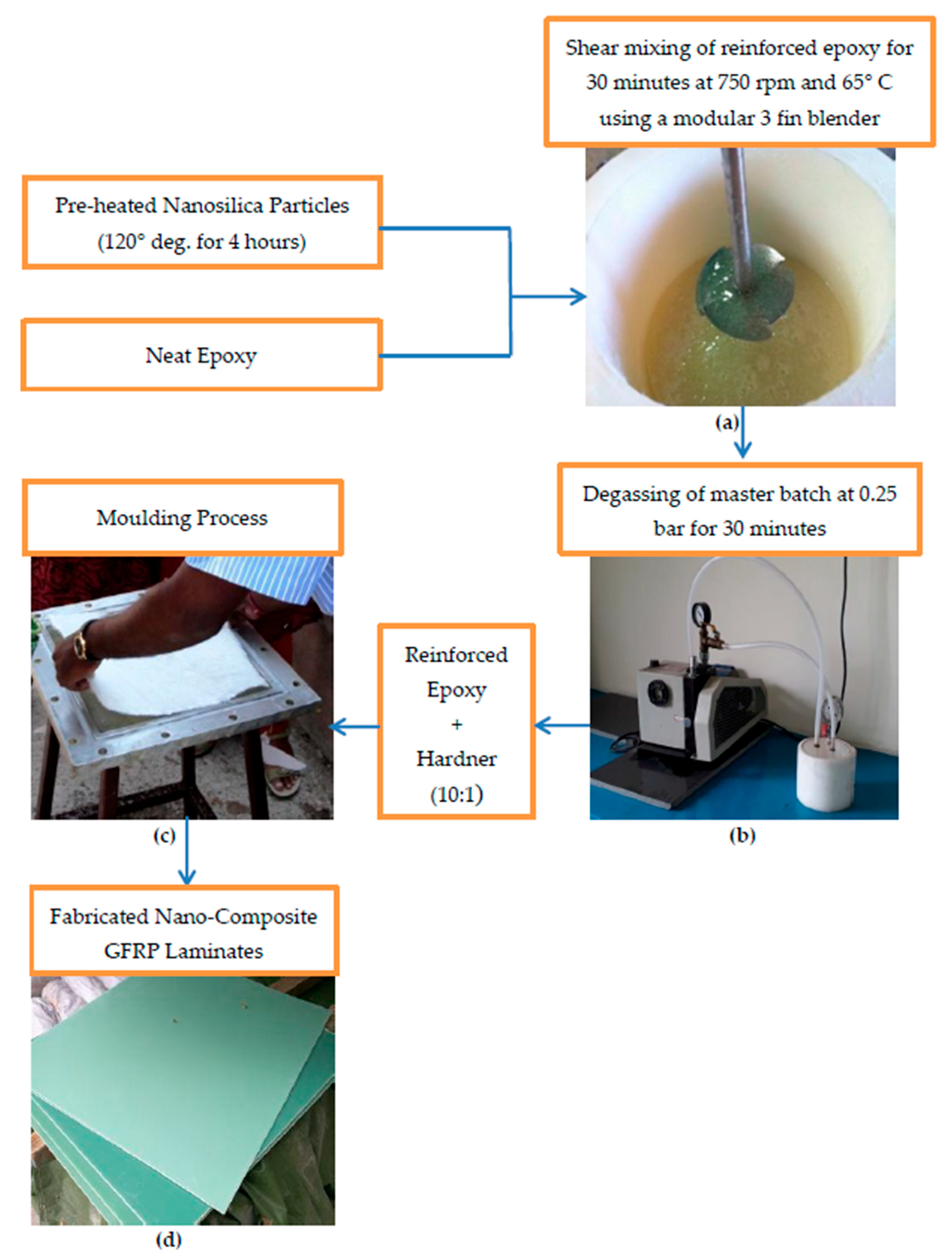
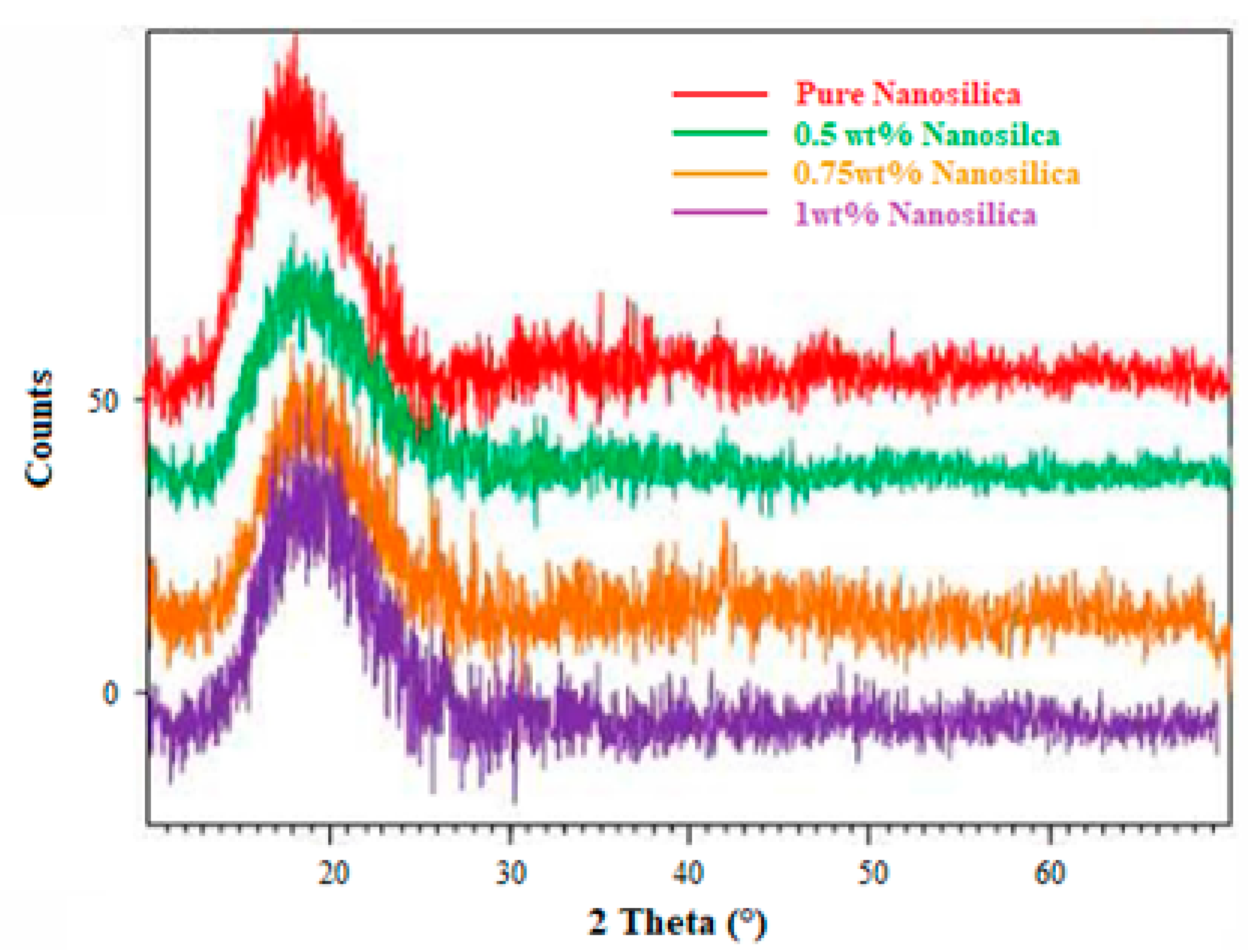

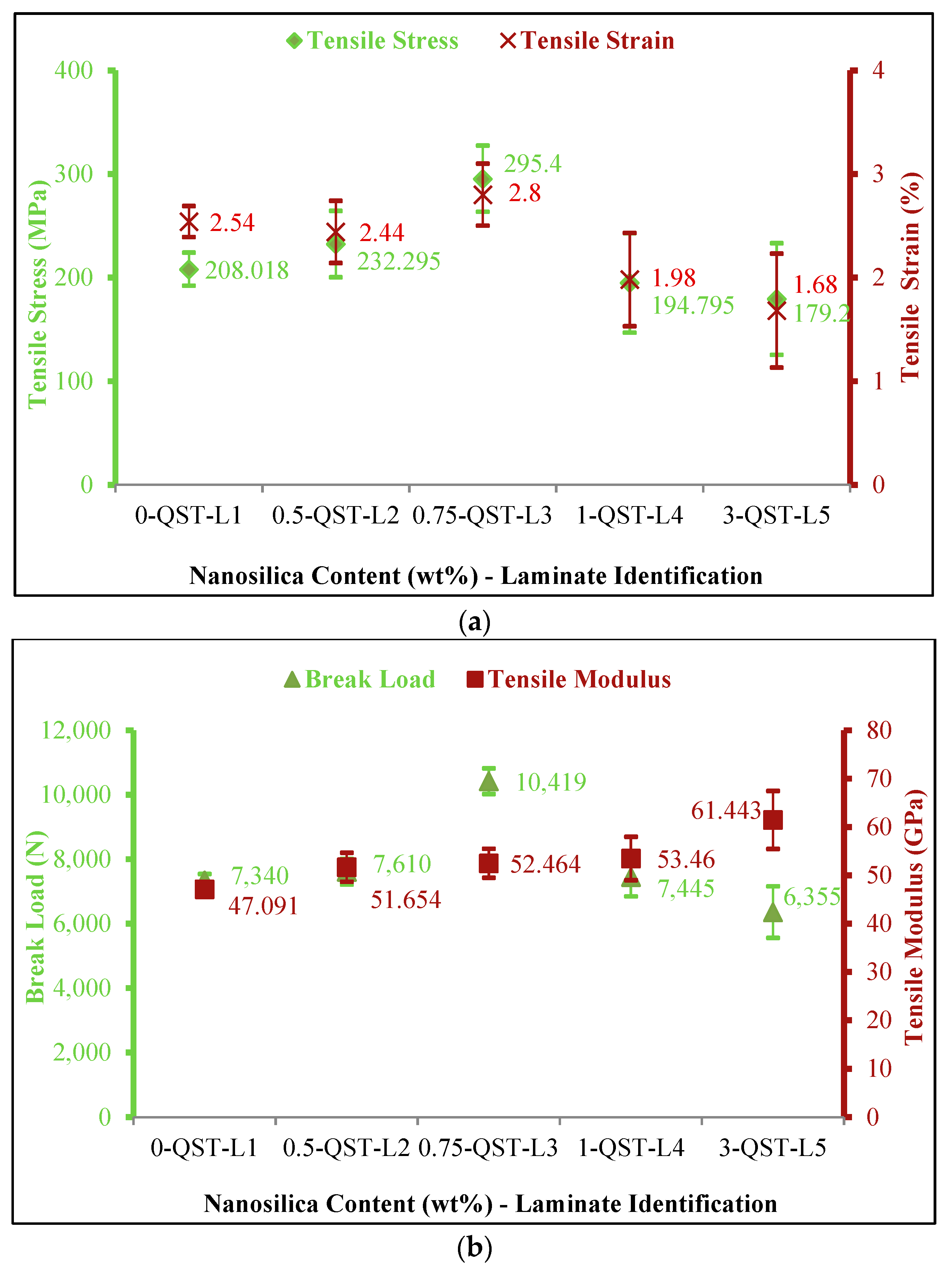
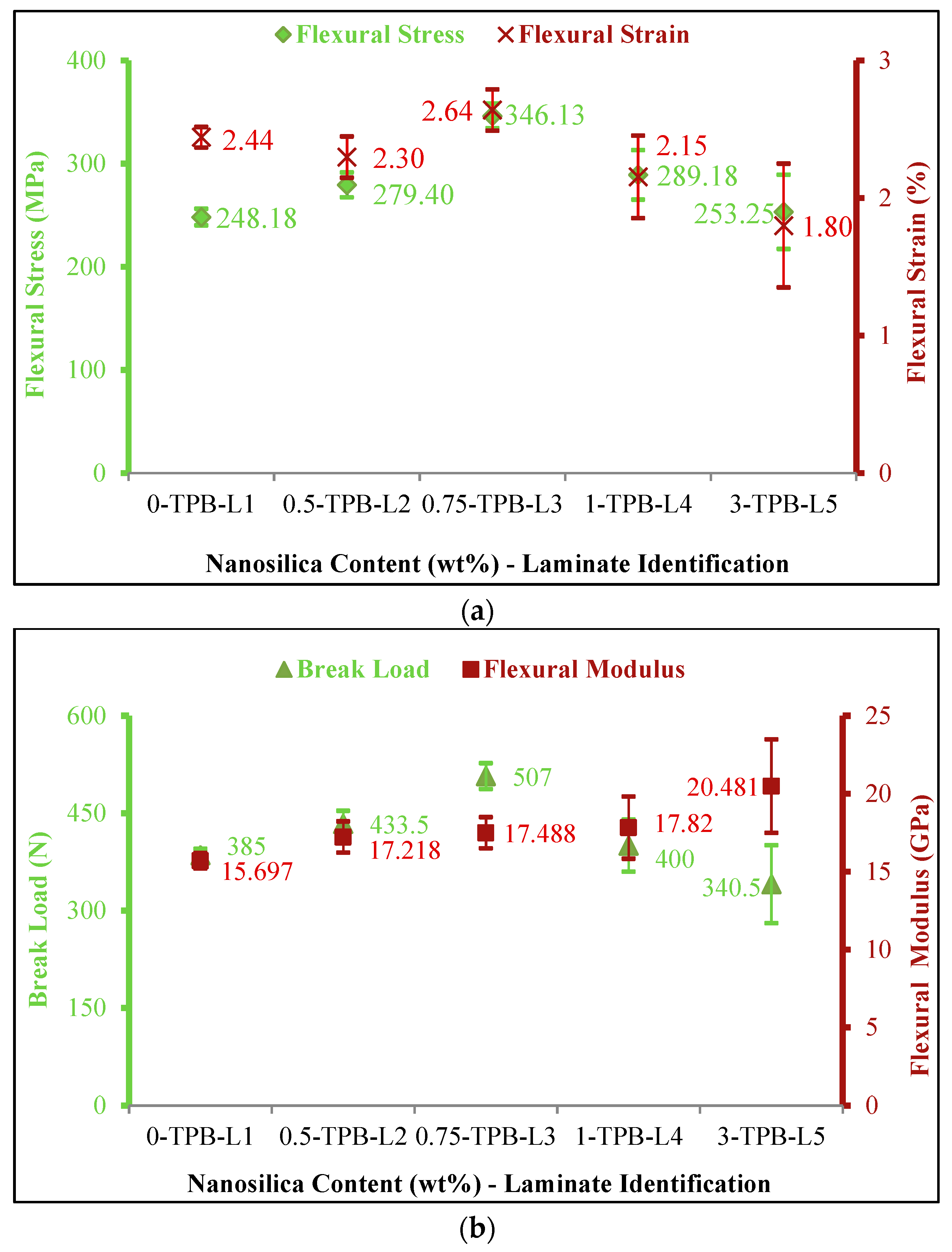
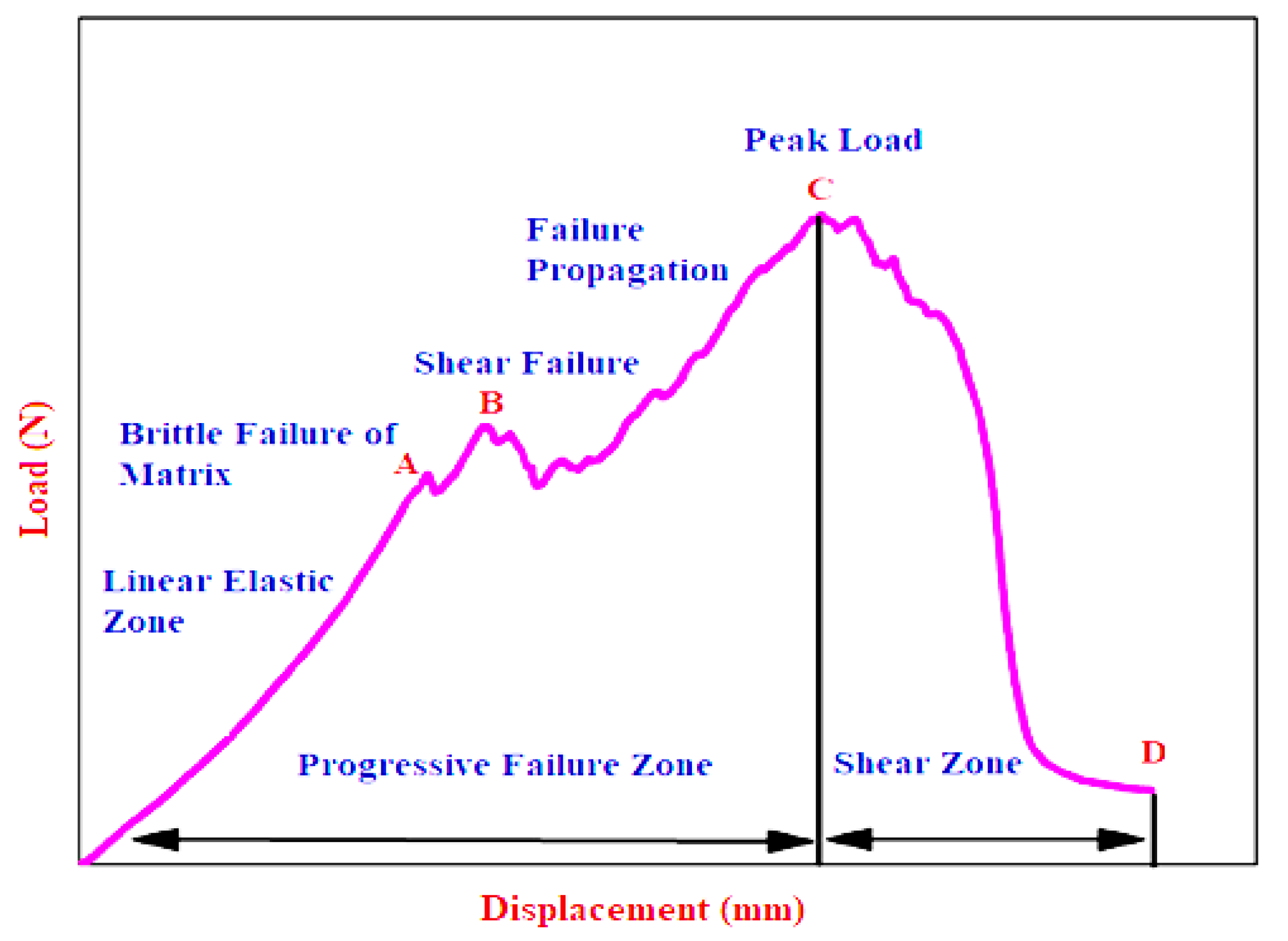


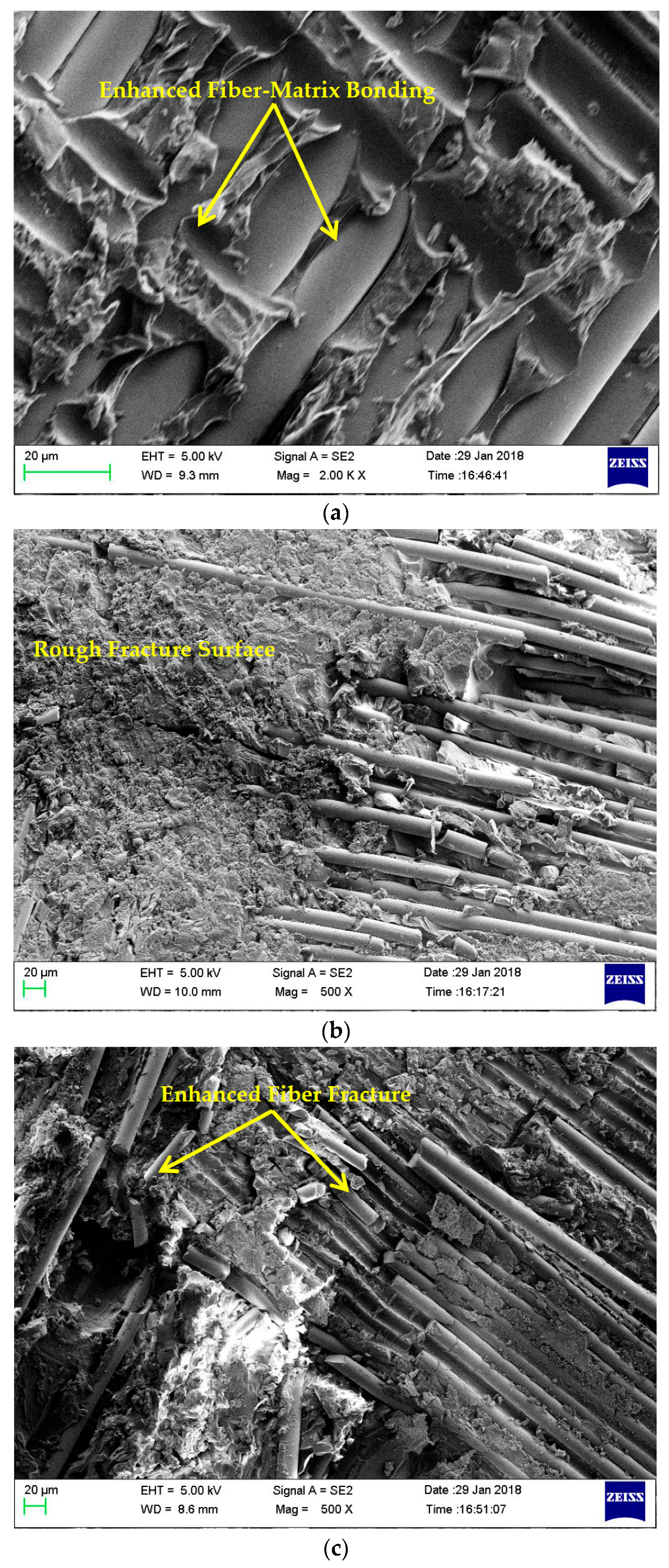
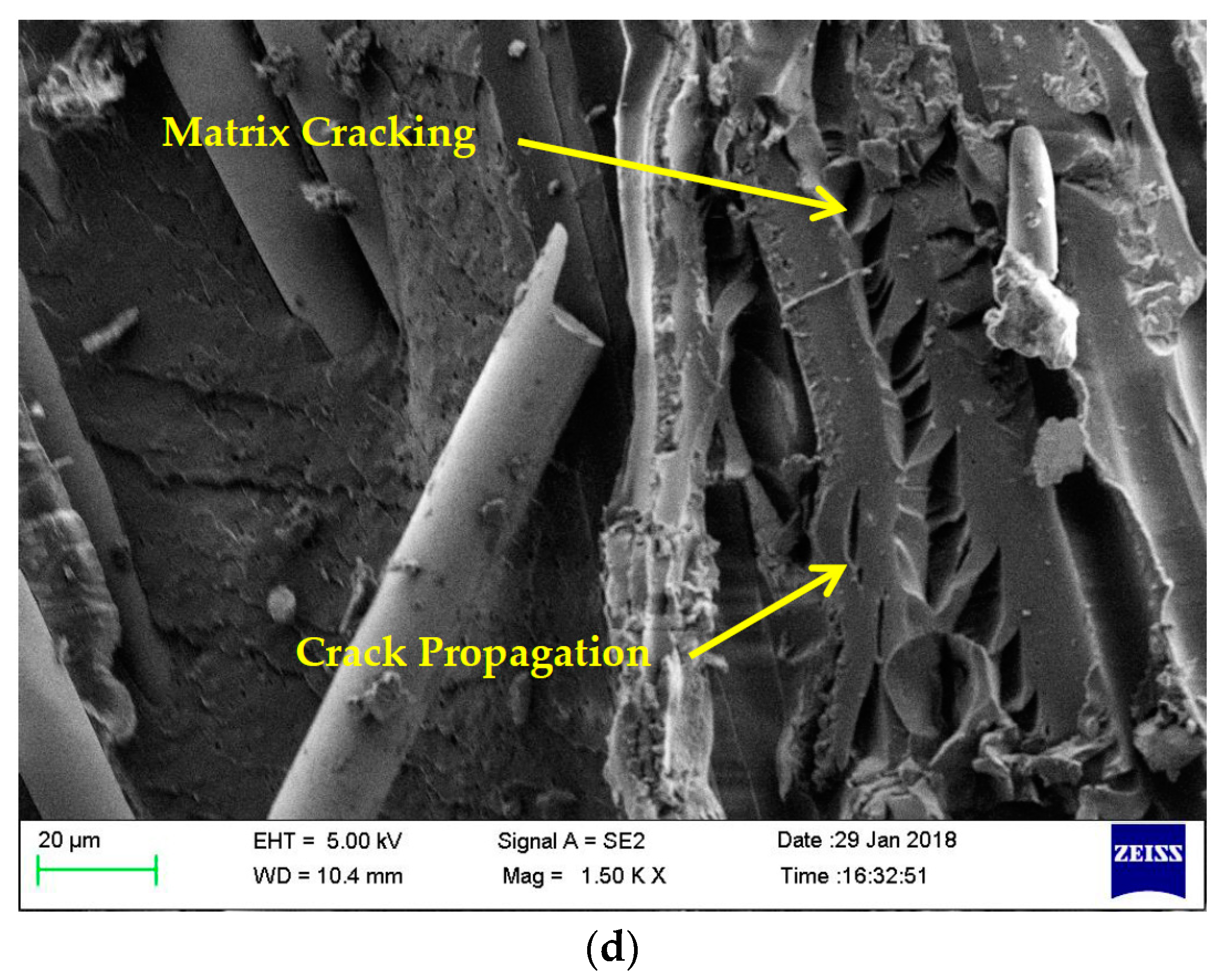
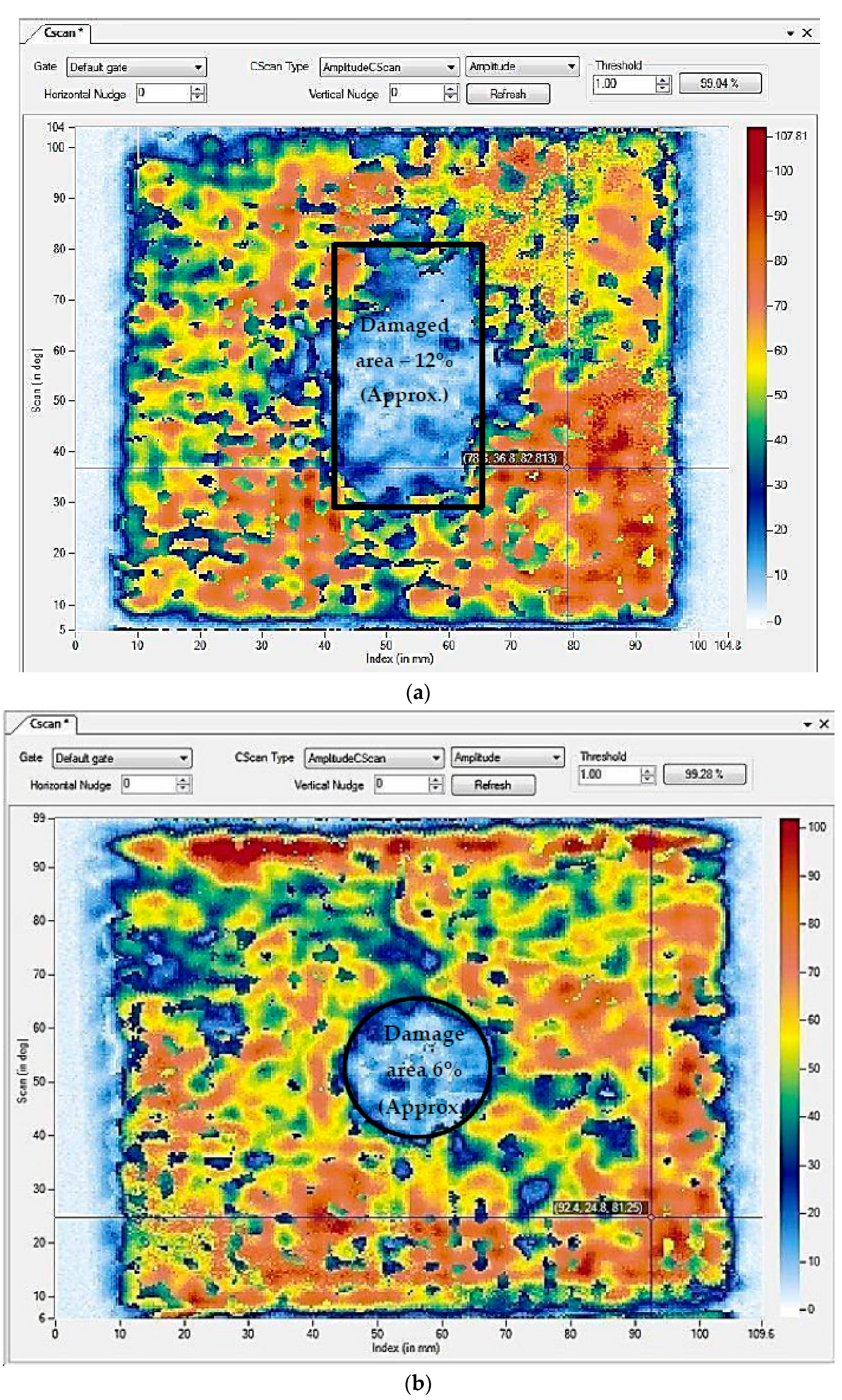
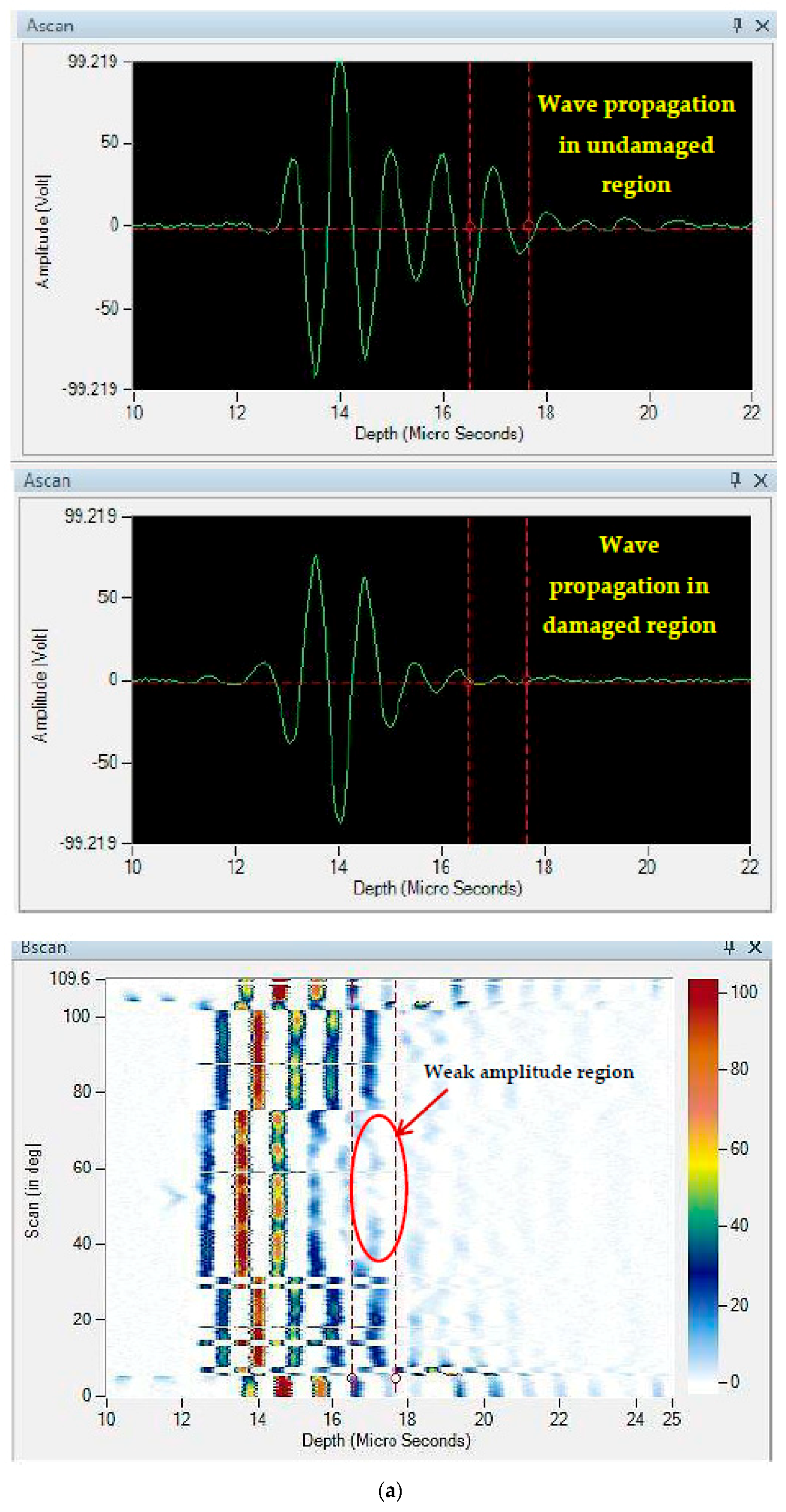
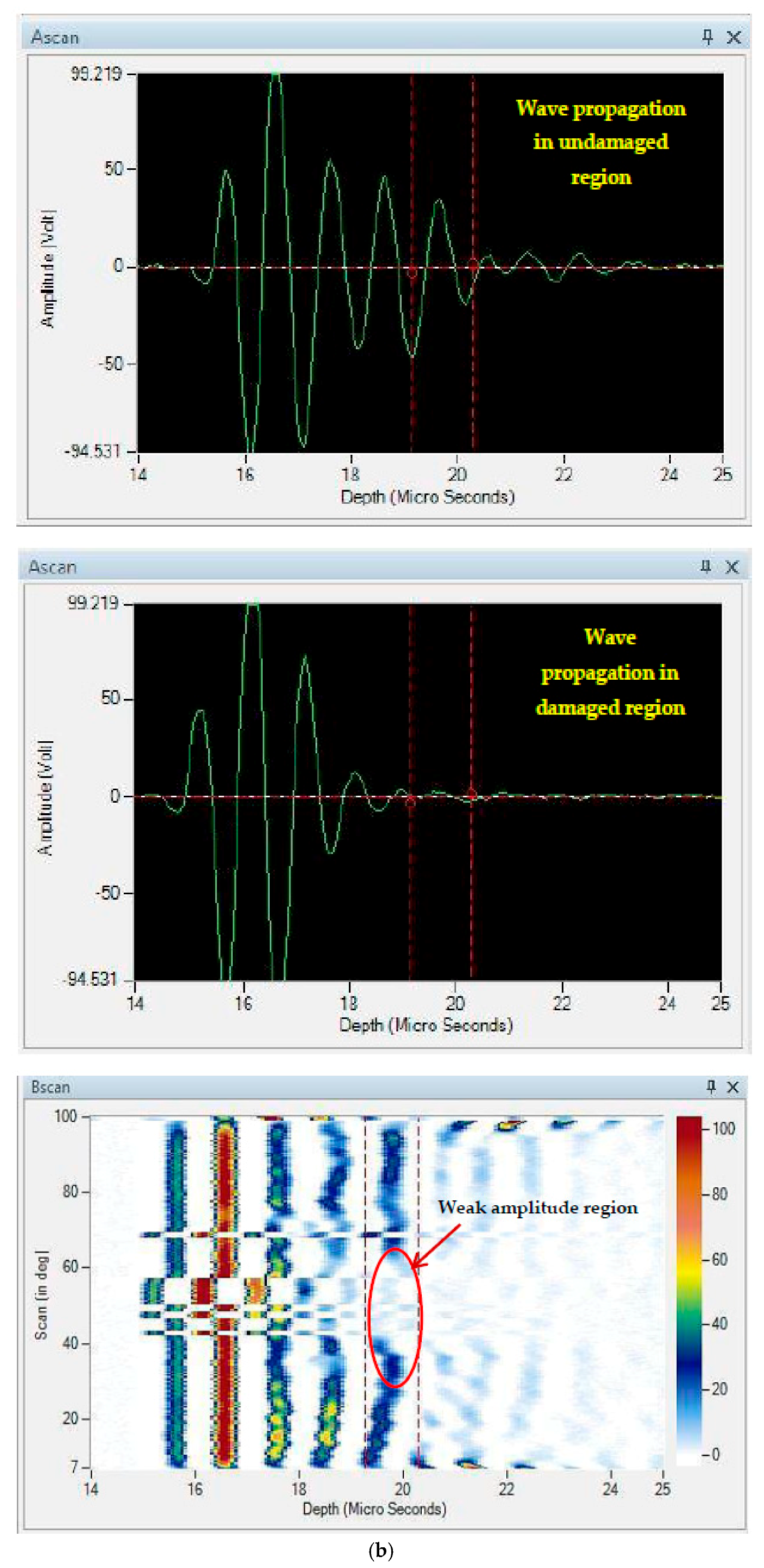
| Property/Grade | E-Glass Fabric | Epoxy LY556 |
|---|---|---|
| Density (g/cm3) | 2.55 | 1.15 |
| Tensile strength (MPa) | 2000–3500 | 80–95 |
| Tensile modulus (GPa) | 70–73 | 0.3–0.6 |
| Grade (GSM) | 610 | |
| Elongation at break (%) | 2.5–3.7 |
| Property | Value |
|---|---|
| Particle size (nm) | 17 |
| Specific surface area (m2/g) | 202 |
| Ph. value | 4.12 |
| Tamped density (g/L) | 44 |
| SiO2 content (%) | 99.88 |
| Laminate Identification | Nanosilica Content (wt%) | Glass Transition Temperature (Tg) | Loss Modulus (MPa) | Damping Factor (tan δ) |
|---|---|---|---|---|
| DMA-L1 | 0 | 73.02 | 920 | 0.3347 |
| DMA-L2 | 0.5 | 69.83 | 1188 | 0.455 |
| DMA-L3 | 0.75 | 63.61 | 1261 | 0.499 |
| DMA-L4 | 1 | 68.72 | 1008 | 0.426 |
| Sample No. | Nanosilica Content (wt%) | Compressive Stress (MPa) | Stiffness (MPa) | Peak Compressive Force (N) | Time to Peak Force (s) | Strain at Elastic Limit (mm) | Strain at Peak Force (mm) | Total Energy Till Peak Force (J) |
|---|---|---|---|---|---|---|---|---|
| QSI-L1 | 0 | 20.64 | 107.76 | 2984.49 | 71.3 | 4.01 | 5.99 | 9.7 |
| QSI-L2 | 0.25 | 23.84 | 121.80 | 3447.76 | 77.05 | 4.489 | 6.433 | 12.01 |
| QSI-L3 | 0.5 | 28.71 | 132.89 | 4152.15 | 83.4 | 5.18 | 6.923 | 14.03 |
| QSI-L4 | 0.75 | 27.55 | 128.9 | 3984.43 | 85.3 | 5.411 | 7.116 | 15.32 |
| QSI-L5 | 1 | 25.33 | 135.74 | 3662.62 | 83.3 | 5.196 | 6.874 | 13.42 |
© 2018 by the authors. Licensee MDPI, Basel, Switzerland. This article is an open access article distributed under the terms and conditions of the Creative Commons Attribution (CC BY) license (http://creativecommons.org/licenses/by/4.0/).
Share and Cite
Lazar, P.J.L.; Sengottuvelu, R.; Natarajan, E. Assessments of Secondary Reinforcement of Epoxy Matrix-Glass Fibre Composite Laminates through Nanosilica (SiO2). Materials 2018, 11, 2186. https://doi.org/10.3390/ma11112186
Lazar PJL, Sengottuvelu R, Natarajan E. Assessments of Secondary Reinforcement of Epoxy Matrix-Glass Fibre Composite Laminates through Nanosilica (SiO2). Materials. 2018; 11(11):2186. https://doi.org/10.3390/ma11112186
Chicago/Turabian StyleLazar, Prince Jeya Lal, Ramesh Sengottuvelu, and Elango Natarajan. 2018. "Assessments of Secondary Reinforcement of Epoxy Matrix-Glass Fibre Composite Laminates through Nanosilica (SiO2)" Materials 11, no. 11: 2186. https://doi.org/10.3390/ma11112186







